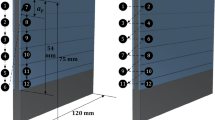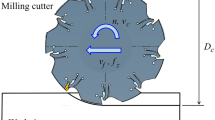Abstract
Chamfered milling tools are commonly used in industrial machining. They stand out due to a considerable gain of process stability, which results in a higher material removal rate compared to non-chamfered tools and therefore in a higher process productivity. Especially the aerospace industry with high material removal rates benefits of an increased productivity by the introduction of chamfered cutting edges. The wide use of chamfered tools and the high quality requirements in the aerospace industry require a model able to predict the surface topography of machined parts with respect to a chamfered cutting edge. To determine the deflection of resilient parts, the effect of the chamfer on the process forces has to be taken into account. This paper presents an analytical model to predict the surface topography of thin-walled, resilient parts after flank milling. Based on mathematical descriptions of the tool kinematics the trajectories of the cutting and the chamfer edge are described. They are used to determine the theoretical engagement conditions and to describe the undeformed chip geometry. Furthermore, the influence of a runout of the tools is considered. The undeformed chip thickness is used to calculate the milling forces along the cutting edge and to predict the resulting deflection of the workpiece. The model presented determines the 3-dimensional topography of the surface by merging the surface profile in feed and the deflection of the workpiece in feed normal direction. The model offers a fast approach for the determination of the influence of the chamfer on the surface topography and a change of the process forces.











Similar content being viewed by others
References
Byrne G, Dornfeld D, Denkena B (2003) Advancing cutting technology. CIRP Annals Manuf Technol 52(2):483–507
Lange M (2006) Hochleistungsfräsen von Aluminium-Struktur-bau-teil-en. In: Proceedings of the 7th Schmalkalder Werkzeugtagung, 08/09 Nov 2006. Schmalkalden
Bachrathy D, Insperger T, Stépán G (2009) Surface properties of the machined workpiece for helical mills. Mach Sci Technol 13:227–245
Surmann T (2006) Geometrisch-physikalische Simulation der Prozessdynamik für das fünfachsige Fräsen von Freiformflächen. Dr.-Ing. Thesis, University of Dortmund
Weinert K, Surmann T, Enk D, Webber O (2007) The effect of runout on the milling tool vibration and surface quality. Prod Eng 1(3):265–270
Weinert K, Surmann T (2006) Modeling of surface structures resulting from vibrating milling tools. Prod Eng Res Dev 13(2):133–138
Biermann D, Heilmann M (2010) Improvement of workpiece quality in face milling of aluminum alloys. J Mater Process Technol 210(14):1968–1975
Groppe M (2005) Prozessauslegung für Hochleistungsfräsbearbeitung von Aluminium-Strukturbauteilen. Dr.-Ing. Thesis, University of Hannover
Denkena B, Schmidt C (2007) Experimental investigation and simulation of machining thin-walled workpieces. Prod Eng Res Dev 1(4):343–350
Klobasa I (2007) Analytische Berechnung der Flankengestalt beim Nut-en-fräsen. Dr.-Ing. Thesis, University of Hannover
An QL, Li JL, Ming WW, Chen M (2009) Finite simulation on face milling of austenitic stainless steel with chamfered tools. Key Eng Mat 392–394:1042–1046
Khalili K, Safaei M (2009) FEM analysis of edge preparation for chamfered tools. Int J Mat Form 2:217–224
Sellmeier V, Hackeloeer F, Denkena B (2009) Process damping in milling––measurement of process damping forces for chamfered tools by means of an electromagnetically guided spindle. In: Proceedings of the 12th CIRP conference on modeling of machining operations, 2009. pp 911–918
Budak E (2008) A new method for identification and modeling of process damping in machining. In: 1st international conference of process machine interactions, 2008. Hannover
Li XP, Li HZ (2003) Analytical modeling of the milling process geometry based on the true tooth trajectory. J Eng Manuf 217:1041–1046
Reuleaux F (1900) Lehrbuch der Kinematik. F. Vieweg und Sohn, 2
Martellotti ME (1941) An analysis of the milling process. Trans ASME 63:677–700
Engin S, Altintas Y (2001) Mechanics and dynamics of general milling cutters. Part I: helical end mills. Int J Manuf Sci Eng 41:2195–2212
Altintas Y, Lee P (1998) Mechanics and dynamics of ball end milling. Trans ASME 120:684–692
Gey C (2002) Prozessauslegung für das Flankenfräsen von Titan. Dr.-Ing. Thesis, University of Hannover
Herget T (1994) Simulation des zeitlichen Verlaufs von Zerspankraftkomponenten beim Hochgeschwindigkeitsfräsen. Dr.-Ing. Thesis, University of Darmstadt
Acknowledgments
The results presented in this paper were obtained within the research project “DE447/69 Gestaltabweichungen beim Flankenfräsen”. The authors thank the German Research Foundation (DFG) for the financial support of this project.
Author information
Authors and Affiliations
Corresponding author
Rights and permissions
About this article
Cite this article
Denkena, B., Köhler, J., Sellmeier, V. et al. Topography prediction of resilient parts after flank milling with chamfered tools. Prod. Eng. Res. Devel. 5, 273–281 (2011). https://doi.org/10.1007/s11740-011-0305-2
Received:
Accepted:
Published:
Issue Date:
DOI: https://doi.org/10.1007/s11740-011-0305-2




